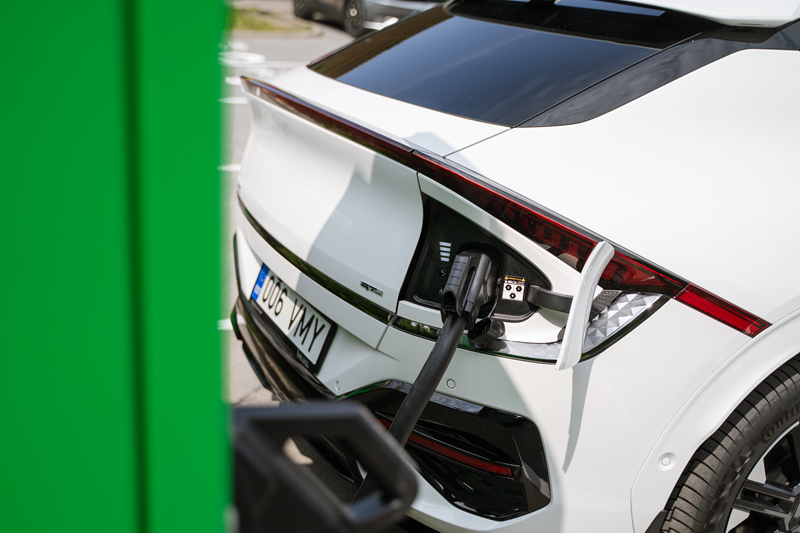Prices dropping to zero for a few hours last week does not mean that Europe has finally come out of the energy crisis. Although the launch of the Olkiluoto 3 nuclear power plant and the completion of new wind farms will bring some relief to our pricing area, winter may be difficult in the event of the worst scenario.
| Price zone | Average exchange price | Change (previous week) |
| Estonia | 40.2 €/MWh | -53,5% |
| Latvia | 40.2 €/MWh | -53,5% |
| Lithuania | 42.5 €/MWh | -51,1% |
| Finland | 37.6 €/MWh | -54,7% |
Last week the electricity price in Estonia was on average 40.2 €/MWh (–46.3 €/MWh compared to the previous week). Electricity was the most expensive last Tuesday evening at 20:00, at which time the price was 121.92 €/MWh. The cheapest hourly price was at 03:00 on Thursday 13 April, when electricity was available free of charge on the exchange.
The Olkiluoto 3 nuclear power plant, whose construction started in 2005, was completed
In the weekly comparison, the average electricity price fell by more than 2 times, caused by lower fuel prices and warmer weather. The Olkiluoto 3 nuclear power plant, which was officially completed this Monday after a 14-year delay, operated all week and started electricity production under commercial conditions. The plant has a significant impact on the Finnish energy market, as its annual production covers 14% of Finland’s electricity needs as well as the deficit caused by the discontinuation of electricity imports from Russia last February after its military attack on Ukraine. As Finland’s new nuclear power plant has been operating in test mode at nearly maximum capacity since the beginning of the year, the impact on the electricity price is already included in the price, and the announcement of its official completion did not have a major effect on the price overnight.
Last week, Germany finalised its plans to abandon nuclear energy when the country’s last 3 nuclear power plants with a total capacity of more than 4 gigawatts were permanently shut down. The service life of the plants was extended over winter to be ready in case Europe ran out of gas during the winter. The final nuclear power plants accounted for about 5% of the country’s electricity output in the first quarter of this year, and nuclear energy accounted for only 6% of Germany’s electricity output last year. By comparison, the share of renewable energy was 44%.
While Europe makes an effort to develop renewable energy in order to achieve energy independence and a green transition, the energy economy based on fossil fuels persists worldwide. Although India has set ambitious carbon neutrality targets for itself, their acute energy deficit is met by coal. Over the next year, India plans to announce the construction of coal plants with a total capacity of around 4.5 gigawatts and to increase coal mining by as much as 48% per year. There are parallel discussions about plans to produce green hydrogen and establish renewable production capacity, but these plans are more abstract.
According to calculations by think tank Ember, the amount of carbon dioxide generated by electricity production may have reached its peak in 2022, and may start to decrease as soon as this year thanks to rapid growth in solar and wind energy. According to Ember analysts, the end of the fossil fuels era has arrived. Although an all-time record was set last year for coal-based energy production, the reduction of emissions in 2023 could be helped by limiting energy consumption and the recovery of nuclear and hydroelectric power, which suffered last year due to maintenance issues and drought respectively.
The International Energy Agency (IEA) warns that the decision of the OPEC+ oil cartel to reduce oil production by 1 million barrels per day from 1 April will push oil prices up and make the life of those already facing difficulties due to high inflation even more difficult. According to the agency, the unexpected production cut by the cartel led by Saudi Arabia will force 2 million barrels per day to be taken from oil reserves in the second half of the year and will put the oil market, which was in deficit even before this decision, into an even worse tailspin.
At the same time, world oil consumption is expected to increase by 2 million barrels per day and reach a new record of 101.9 barrels per day. The majority of the growth is led by China, whose opening economy needed an additional 1.2 million barrels per day in the first quarter, according to IEA data.
The average weekly gas price was 42.6 €/MWh (−3,8 €/MWh compared to last week). Warmer weather is expected across Europe this week, which may contribute to a further reduction in heat demand and keep the capacity of Europe’s gas storage facilities at their current high level. However, colder weather is forecast for next week, which coincides with the seasonal maintenance of Norwegian gas fields. This may consequently put some pressure on gas prices towards the end of the month.
Limiting Russian LNG would not cut Russian revenues, but would increase the price of gas in Europe
In view of the coming winter, the European Network of Transmission System Operators for Gas (ENTSO-G) issued a positive message, estimating that the European Union will be able to fill its gas storage facilities to at least 90% by October. This is even if Russia fully cuts off pipeline gas supply. However, it is necessary to ensure the security of supply of other sources. Compared to the same time last year, the capacity of the storage facilities is nearly twice as good at around 56%, and stocks have been replenished in the last month. According to the ENTSO-G model, the European Union would buy a third of its gas this summer from Norway and a third as LNG from various sources. 17% would be covered by own production, 10% would be purchased from Algeria, 4% from the Caspian region and 2% from Libya.
At the same time, ENTSO-G warned that if Russia completely cuts off pipeline gas supply and Europe is hit with a significantly colder winter, European countries would have to reduce gas consumption by 6–13% compared to average consumption. If Russia stops selling gas, stocks would fall to 11% by March 2024 in the case of a normal winter, but if this coincides with a harsh winter, only 2% of the stocks would remain by next spring. The situation could be mitigated by cutting consumption by at least 15%, additional LNG supplies and European countries cooperating to meet needs where the situation is most dire.
Patrick Pouyanne, CEO of energy company TotalEnergies, also warned that the crisis in Europe that skyrocketed the price of natural gas over the past two years is far from over. The economic union is facing intense competition for the resources required for energy and heat production. Europe will need to start stockpiling for winter at a time when the Chinese economy is expected to open up more rapidly, but at the same time, it is known that LNG supply will not increase significantly until 2026 when new LNG supply points are completed.
In the last few months, there has been talk of a pan-European ban on LNG imports from Russia. According to analysts, this would not change the market balance. Although Europe imports only 10% of Russia’s pipeline gas compared to the pre-war period, the amount of LNG purchased from Moscow is setting records. Russia has been the second largest supplier of LNG to the European Union this year, and third last year after the US and Qatar. According to analysts who spoke with Montel, reaching a total import ban would be extremely difficult, and country-specific bans would simply drive the ships to the port of the next country. As LNG can be transported by tankers across the world’s seas, a full embargo would replace the Kremlin LNG with that of another country after a short shock period, which would mean price increases in Europe due to longer transport routes.
LNG prices to Europe dropped to a 21-month low this week thanks to steeper discounts by sellers due to intensified competition caused by increasing excess in Europe.
At the same time, the disruption at the Aasta Hansteen gas field in Norway reduced Norwegian gas supply to Europe by 17 million cubic metres per day.
The average weekly CO2 price was 95.7 €/t (–0.3 €/t compared to the previous week), remaining at the same level as the previous week.
The Narva stations of Eesti Energia provided up to 118 MW to the market last week. The 3rd energy block of the Eesti power plant is under maintenance until May and the 4th energy block is undergoing annual maintenance until September.
The price of electricity is formed per hour based on the exchange price, depending on the production capacity and consumer demand in each particular hour, as well as interstate limitations on transmission capacity.
Olavi Miller, Market Analysis Strategist at Eesti Energia
The market overview has been compiled by Eesti Energia according to the best current knowledge. The information provided is based on public information. The market overview is presented as informative material and not as a promise, proposal or official forecast by Eesti Energia. Due to rapid changes in the regulation of the electricity market, the market overview or the information contained in it is not final and may not correspond to future situations. Eesti Energia is not liable for any costs or damages that may arise in connection with the use of the information provided.



